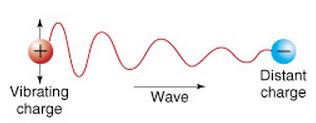I am attempting to learn about electromagnetic waves. From my understanding, when two particles are a distance away from eachother, and one vibrates up and down, the stationary particle will experience a changing electric force that takes the form of a wave (in the sense that it goes up and down harmonically).
I've made the assumption that a stationary particle closer to the vibrating particle will experience a larger change in electric force than a particle that is further away. I think this because a closer particle will see a larger angle between the max and min of the vibrating particle's displacement. I've illustrated how I see it in the following picture:

The positive charge vibrates up and down. Stationary particle 1, since it is close, experiences a dramatic change in the electric field, while particle 2 experiences a smaller change (The two electric force vectors ive drawn on each stationary particle represent the electric forces experienced when the positive charged has reached its max and min displacement).
This all makes sense to me, until I saw the following diagram:

Assuming the wave represents the direction of the electric force experienced by the stationary particle as the positive charge vibrates, then it doesnt seem to make sense to me at all. Why would the "angle" increase the further away you are from the charge?
I later ran into this diagram, which agrees much more with my illustration:

Are the waves in these two diagrams representing different things? Is one of them wrong? Where am I mistaken?



